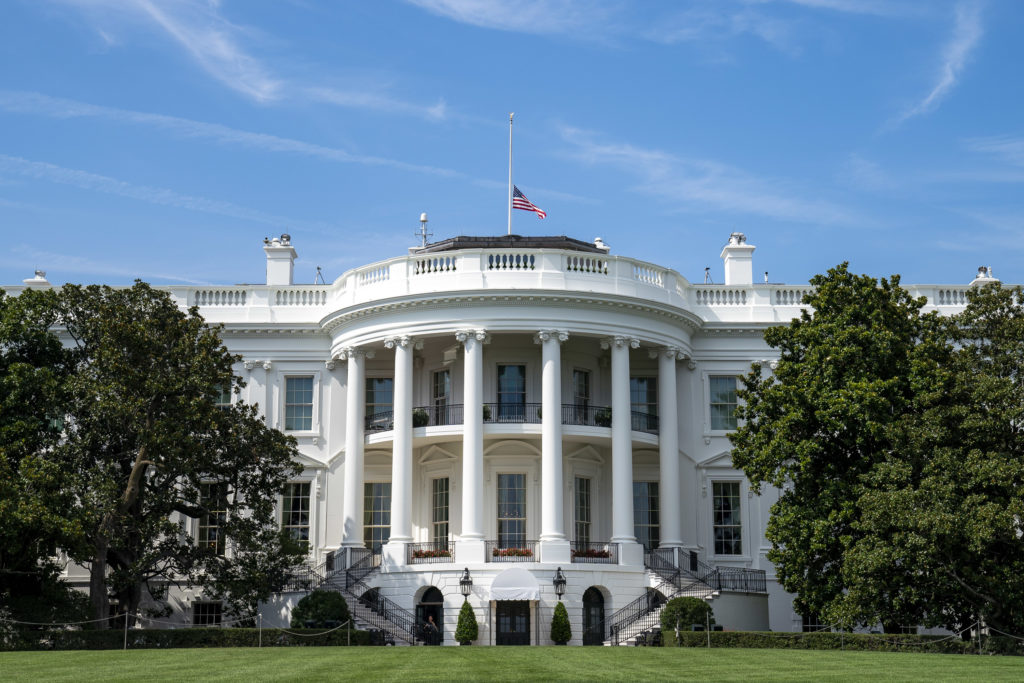The Classification Status of Trump’s Mar-a-Lago Documents
Why classification status matters for 18 U.S.C. § 793 and what limitations may exist for a president’s declassification authorities.

Published by The Lawfare Institute
in Cooperation With

In the wake of the execution of the search warrant at Mar-a-Lago, two issues that have received attention are the scope of a president’s declassification authority and the relevance of the classification of the documents recovered in the search. Former president Trump claims he had a standing order to declassify documents as soon as they left the oval office. Several experts have pointed out the absurdity of such a claim, describing it as “preposterous,” “idiotic and dumb,” and “utter baloney.” A recent New York Times article attempted to explain the parameters of a president’s declassification authority, but the explanation and the news coverage of that issue to date gloss over important nuances worth analyzing further. In addition, that same New York Times article described the classification status as “legally irrelevant,” which is not quite accurate, at least when it comes to the inclusion of 18 U.S.C. § 793 in the search warrant.
Let’s start with the relevance of classification to 18 U.S.C. § 793. It’s true that the statute refers to “information relating to the national defense,” not classified information. But according to two consequential cases that interpreted the phrase “information relating to the national defense” in the Espionage Act—one a Supreme Court opinion, Gorin v. United States, and the other a Second Circuit opinion by Judge Learned Hand, United States v. Heine—“information relating to the national defense” is a broad term encompassing activities relating to national preparedness, but it must also be information for which the government has taken some steps to keep it secret. (Since the classification system currently in place had yet to be invented at the time of these cases, this wasn’t meant to refer to information formally classified as “secret.”) Later cases—see here and here, for example—have interpreted this “secrecy” aspect to require that the information be “closely held,” a phrase frequently used in jury instructions for cases involving 18 U.S.C. § 793.
In addition, the same cases have also interpreted the secrecy requirement from Gorin and Heine to mean that disclosure of the information at issue must be potentially damaging to the United States or useful to an enemy of the United States. As Judge Ellis stated in United States v. Rosen (citing Gorin), “the statute only applies to information for which there is an ‘occasion for secrecy,’ and there is no ‘occasion for secrecy’ unless disclosure of the information the government seeks to protect implicates an important government interest such as the national security.” Therefore, under case law, information relating to national defense must be information that is both closely held and potentially damaging to the United States or useful to an enemy of the United States if disclosed. These judicially imposed limitations on the term have saved it from vagueness challenges. The continued classification of the information is how the government usually proves that it meets both of these requirements.
While it is possible, though rare, for certain unclassified information to be both “closely held” and potentially damaging to the United States (therefore meeting both judicially imposed requirements), the declassification of information that had previously been classified would suggest the information no longer merits being closely held and would not be damaging to the United States if disclosed. Although the public does not know all the facts regarding what is in the documents recovered from Mar-a-Lago or what, if any, formal steps may have actually been taken for declassification, the classification status of the information is relevant to a discussion of potential charges under 18 U.S.C. § 793 and certainly would be considered by prosecutors evaluating the matter.
Having covered the relevance of the classification status, let’s turn to the declassification issue. Do presidents have blanket authority to declassify anything they want, any time they want, in any manner they want? Could President Trump just say (or have someone say for him) that while he was still president, he waved his magic declassification wand over any information labeled as classified that was ultimately stored at Mar-a-Lago, and presto, no one could do anything about it? Three sources to use in answering that question are Executive Order 13526 (the executive order governing classified national security information), Article II of the Constitution (which sets forth the broad authority of the executive), and a Supreme Court case, Department of Navy v. Egan.
Executive Order 13526
Executive Order 13526 (EO 13526) is the most recent in a series of executive orders promulgated by U.S. presidents to govern the handling of classified information, put forth by President Barack Obama in 2009. With respect to the authority to designate information as classified, in Section 1.3(a)(1), EO 13526 explicitly states that the president is an “original classification authority,” meaning he can decide on his own whether information should be classified.
With respect to declassification, the EO’s wording is a little different. Rather than explicitly listing the president as having declassification authority, EO 13526 states:
Sec. 3.1. Authority for Declassification.
- Information shall be declassified as soon as it no longer meets the standards for classification under this order.
- Information shall be declassified or downgraded by:
- the official who authorized the original classification, if that official is still serving in the same position and has original classification authority
- the originator’s current successor in function, if that individual has original classification authority;
- a supervisory official of either the originator or his or her successor in function, if the supervisory official has original classification authority; or
- officials delegated declassification authority in writing by the agency head or the senior agency official of the originating agency.
So, the EO does not specifically list a president as someone who can declassify information, even though it does list the president as someone who can classify information. A president could hold the declassification authority listed in Section 3.1(b)(1) of EO 13526 if he were the one who had authorized an original classification, as long as he was still serving as president. (Namely, President Trump could have declassified information pursuant to EO 13526 for documents brought to Mar-a-Lago up until January 20, 2021 at 11:59 a.m. as long as he was the one who had originally classified the classified information in the boxes.) But if a president was not the one who had originally classified the information (and it is probably unlikely President Trump was the one who classified the information), any authority he might have to declassify that information would not come from Section 3.1(b)(1) of EO 13526.
A better fit might instead be the declassification authority listed in Section 3.1(b)(3), which designates declassification authorities for a supervisory official of an individual who had original classification authority. (For instance, the president could be a supervisory official of the CIA Director or other officials referenced in Section 1.3 of the EO who might have been the original classification authority for certain classified information found during the search.) A president’s ability to declassify under that provision of the EO would expire as soon as he lost his supervisory official status: as soon as he was no longer president. But the question remains: what if he had affirmatively exercised such powers over the Mar-a-Lago documents prior to expiration of his presidency? Would that be consistent with EO 13526, regardless of whether such an action was recorded?
The EO does not shed much light on this point since it does not even refer to presidential declassification, let alone set forth whether any process for such declassification is required. It describes processes for automatic declassification, systematic declassification review, mandatory declassification review, and processing of requests—but none of those address whether a sitting president has any blanket “magic wand” declassification authority. The EO does reference in a number of places the need for agencies with equities in the classified information at issue to have an opportunity to weigh in on declassification (see Sections 3.1(c) and (d) as well as Section 3.3(b)). And, for whatever it is worth, there is no public information indicating that any such consultation with equity holders took place with respect to declassification of the classified information found at Mar-a-Lago.
EO 13526 also has an additional provision regarding declassification where, in exceptional cases, an agency head or a senior agency official can determine that the public interest in disclosure outweighs the need to protect the information. Again, however, there is no public information that the former president ever made such a determination about the documents seized at Mar-a-Lago, and the documents obviously have not been made public at this time.
In summary, EO 13526 gives the president broad classification authority and suggests a possibility for broad presidential declassification authority under certain circumstances, but it doesn’t explicitly provide for such authority—and in a number of places, it incorporates the idea that equity holders should have an opportunity to review proposed declassifications. Overall, EO 13526 doesn’t provide a completely satisfying answer to the presidential declassification question. And, importantly, there is also a separate issue regarding whether an Executive Order would even be binding on a sitting president.
This may be a good place for a quick note about the potential recovery during the search of classified material not governed by EO 13526. The Washington Post reported that classified documents relating to nuclear weapons were among the documents the FBI sought in the search at Mar-a-Lago. Certain nuclear-related information receives a special classification as “Restricted Data” under the Atomic Energy Act. Although the list of items seized did not refer to material classified as Restricted Data, it is worth mentioning that if such material was recovered, the classification of Restricted Data falls under an entirely different classification (and therefore declassification) system. It is not subject to EO 13526. Rather, it is governed exclusively by the Atomic Energy Act. If the Mar-a-Lago documents included Restricted Data, no public information suggests that the relevant “declassification” provisions of that statute have been followed. In fact, under the statute, a president cannot declassify such information on his own. Therefore, such information would remain classified regardless of any attempts made by the former president to declassify it.
The Constitution’s Article II Authority and Department of Navy v. Egan
Stepping back from EO 13526’s narrower mandate, let’s look at a much broader authority that might shed light on presidential declassification: the Constitution. The president’s ultimate authority to classify information and control access to such information stems from his Article II authority under the Constitution (U.S. Constitution, Art II, Section 2), which says the president shall be commander-in-chief of the U.S. army and navy. A heavily cited Supreme Court case from the 1980s, Department of Navy v. Egan, reviewed the Executive Branch’s authority to grant and deny security clearances, and delineated a broad view of the president’s classifying authorities as commander-in-chief: “[The President’s] authority to classify and control access to information bearing on national security and to determine whether an individual is sufficiently trustworthy to occupy a position in the Executive Branch that will give that person access to such information flows primarily from this constitutional investment of power in the President and exists quite apart from any explicit congressional grant.”
The language sounds pretty broad and, at first blush, may seem to give the president authority to do as he wishes with any classified information. But does it? The Article II language presupposes, as Egan holds, that the president has ultimate authority to control access to national security information. This may mean that if a president decides, on the fly, that he wants to convey highly classified information to Russian officials—as President Trump apparently did in 2017—that could be consistent with authorities given to him by the Constitution. (Note, though, that Article II’s conference of authority was likely granted under the assumption that the president would make any such decision in the interest of the national security of the United States and not for personal reasons.)
But does the language of Article II go beyond that ostensibly principled national security decision-making to allow a president to remove classified information to an unsecure location and purportedly attempt to declassify it, for no apparent national security reason and with no documented process or consultation with the information’s equity holders? On the one hand, one might try to argue that the language in Egan regarding the president’s breadth of authority to “control access” would include moving materials to a location that would be his home once he left office. But on the other hand, would such a reading really be consistent with Article II, without any additional national security basis for the removal of the documents? One could argue the oral disclosure by a president to a foreign official might be consistent with what the founders had in mind when they designated the president as the commander-in-chief, but the removal and attempted declassification of a seemingly wide array of classified documents as in this instance—as a president was leaving office after a lost election, without any stated reason or documentation for the removal and attempted declassification—seems quite far afield from the founders’ intentions. At least one recent court opinion from 2020 (New York Times v. CIA) articulated the point that the reading of the president’s broad Article II power in Egan does have its limits: “ ... declassification, even by the president, must follow established procedures ...”
After President Trump’s disclosure of classified information to the Russian ambassador and the Russian foreign minister in 2017, some said the president had done nothing wrong: that he had every right to share whatever he wanted with whomever he wanted, classification of the information be damned. Even some who lamented the disclosures for their potential harm to national security conceded that the president had the authority to make them. Others questioned the President’s authority to make the disclosure but accepted that no criminal consequences would follow. A small number of commentators maintained that his actions could have violated federal law, but the overall consensus back then was that it was not a matter that merited legal consequences, and no legal consequences followed.
The situation this time contains at least three differences that may alter the analysis:
- This was not an oral disclosure by a president of a specific item of classified information to identified individuals. Rather, it appears to have involved removal and retention of multiple classified documents to an unauthorized location. In the absence of any information about what was removed, and why, and what any basis may have been for an attempt at declassification, it is difficult to presume these were actions in the interest of national security and consistent with a president’s Article II authorities.
- Assuming the documents were removed to Mar-a-Lago sometime between December 2020 and 11:59 a.m. on Jan. 20, 2021, the president had been defeated in an election and was on his way out of office at the time the documents were removed. While he remained commander-in-chief through 11:59 a.m. on Jan. 20, 2021 and retained full Article II authorities through that moment, the timing does seem relevant to his motive and intent—especially in the absence, as indicated above, of any information about what was removed and why, and what any basis may have been for an attempted declassification. What possible reason, consistent with Article II, would an outgoing president have for taking these actions during that time?
- The documents were discovered and recovered after Trump was no longer president. His Article II authority had expired by then. If he can’t prove that he declassified them before 11:59 a.m. on Jan. 20, 2021, he lacked the power to do so.
Incidentally, these differences also illustrate how the issue with the Mar-a-Lago documents can be distinguished from a seemingly similar issue that arose in the United States v. Libby case in 2006. In that case, President Bush had, without going through any formal process, authorized disclosure of parts of a classified National Intelligence Estimate (NIE) to a reporter, and that disclosure was purported to be a presidential declassification of the material. As with the incident with President Trump and the Russians in 2017, one could argue this sort of declassification fits within the broad powers of a president’s declassification authorities. And the NIE disclosure had a more obvious connection with a president’s Article II authorities—whatever one thought about the merits of the war in Iraq, the decision to declassify a specific piece of intelligence that supported the administration’s justifications for war is on point with those authorities.
Of note in the Libby case is that, at the time the president had purportedly declassified the information in the NIE for disclosure to a reporter, other senior officials—including cabinet-level officials—were not made aware of the declassification and in fact embarked on separate efforts to get the document declassified through normal agency channels. Libby, who disclosed the information to the reporter after the purported presidential declassification but prior to the formal declassification through regular agency channels, was not charged with disclosing classified information. Some might try to argue those facts illustrate that presidential declassification can occur without others knowing and without a formal process. But charging decisions are quite fact-specific and are subject to prosecutorial discretion, so just because the government did not charge Libby for the disclosure (and thus did not have an occasion to challenge the presidential declassification in that case) is not proof that presidential declassification without formal process and without others knowing is entirely legitimate. And, as indicated above, there are a number of factors just from what is publicly known that distinguish the purported presidential declassification of the Mar-a-Lago documents from what happened in the Libby case and suggest it may be further removed from a president’s authority under Article II.
Final Thoughts on the President’s Declassification Powers
On the issue of what, if any, process is or should be required for a president to declassify information, EO 13526 may not provide definitive answers, but it does suggest the prudence of some process, when possible, that factors in equities and expertise that specific agencies may have regarding the information at issue. In fact, in other instances during the Trump presidency, officials engaged in and showed awareness of the necessity of some sort of declassification process. See, for example, the declassification ordered for the Carter Page FISA Application and other FBI documents.
The Constitution’s broad brush in Article II and cases interpreting Article II may fail to suggest specific requirements the president might have to follow regarding declassification, but one can put forth a common-sense view that the broad power allotted to the president under Article II does have a limitation; it presumes an intent to act in the interest of the national security of the United States. And such a limitation would mean that if a president acts contrary to that interest, the founders would not have intended such actions to receive broad protection under Article II. Without any documentation or articulated reason for declassification of the documents at Mar-a-Lago, it seems hard to claim that such declassification comports with national security of the United States and with the president’s duties to protect national security.
Much remains unknown to the public regarding the Mar-a-Lago documents, and prosecution decisions on cases such as these are extremely fact-specific, so it is hard to speculate on where this matter is heading. Recovery of the classified material for national security reasons was without a doubt the priority. But, as concerns a potential for charges under 18 U.S.C. § 793, the DOJ would certainly consider the classification status of the documents and evaluate potential arguments regarding their declassification.





